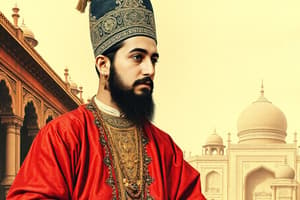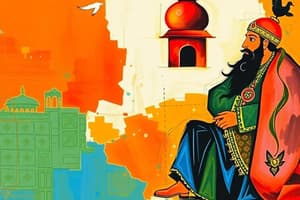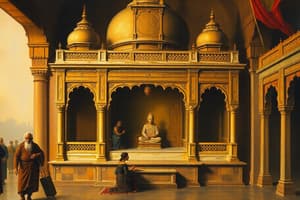Podcast
Questions and Answers
What was Bairam Khan's official title and primary role in Akbar's early reign?
What was Bairam Khan's official title and primary role in Akbar's early reign?
- Vakil (Representative), acting as the primary diplomat for the Mughal Empire
- Senapati (Commander-in-chief), responsible for leading the Mughal armies
- Qazi (Judge), overseeing the legal and judicial matters of the kingdom
- Atgah (Chief Minister), serving as Akbar's guardian and advisor (correct)
Hemu, before his defeat at the Second Battle of Panipat, had already seized Delhi and declared himself the new Mughal Emperor.
Hemu, before his defeat at the Second Battle of Panipat, had already seized Delhi and declared himself the new Mughal Emperor.
False (B)
What pivotal event during the Battle of Panipat led to Hemu's army falling into disarray?
What pivotal event during the Battle of Panipat led to Hemu's army falling into disarray?
Hemu being struck in the eye by an arrow
After the victory at Panipat, Bairam Khan continued to expand the Mughal Empire, conquering territories such as Lahore, Multan, Ajmer, Jaipur, and ______.
After the victory at Panipat, Bairam Khan continued to expand the Mughal Empire, conquering territories such as Lahore, Multan, Ajmer, Jaipur, and ______.
What motivated Akbar to dismiss Bairam Khan in 1560 CE?
What motivated Akbar to dismiss Bairam Khan in 1560 CE?
Akbar, even as a young ruler, never actively participated in battles and only observed from a safe distance.
Akbar, even as a young ruler, never actively participated in battles and only observed from a safe distance.
What was the official reason given for Bairam Khan's removal from his position, allowing Akbar to maintain a semblance of respect for his former guardian?
What was the official reason given for Bairam Khan's removal from his position, allowing Akbar to maintain a semblance of respect for his former guardian?
Match the person to the description:
Match the person to the description:
Akbar's religious policy of sulh-i-kul primarily aimed at:
Akbar's religious policy of sulh-i-kul primarily aimed at:
Din-i-Ilahi gained widespread popularity across the Mughal Empire during Akbar's reign.
Din-i-Ilahi gained widespread popularity across the Mughal Empire during Akbar's reign.
Name one social reform initiated by Akbar that aimed to improve the status of women.
Name one social reform initiated by Akbar that aimed to improve the status of women.
_________, known for his wit and intelligence, was a close advisor to Akbar.
_________, known for his wit and intelligence, was a close advisor to Akbar.
Match the following figures from Akbar's court with their primary contributions:
Match the following figures from Akbar's court with their primary contributions:
Which architectural style is most characteristic of Akbar's building projects, such as the Buland Darwaza?
Which architectural style is most characteristic of Akbar's building projects, such as the Buland Darwaza?
Akbar himself was a highly literate emperor who personally wrote many historical chronicles.
Akbar himself was a highly literate emperor who personally wrote many historical chronicles.
Besides religious tolerance and administrative reforms, what other area saw significant advancement under Akbar's patronage?
Besides religious tolerance and administrative reforms, what other area saw significant advancement under Akbar's patronage?
The __________ is a valuable historical source providing detailed insights into Akbar's reign.
The __________ is a valuable historical source providing detailed insights into Akbar's reign.
What was the primary focus of Din-i-Ilahi?
What was the primary focus of Din-i-Ilahi?
What was Akbar's primary motivation for forging alliances with the Rajputs?
What was Akbar's primary motivation for forging alliances with the Rajputs?
Akbar's policy of religious tolerance and cultural integration laid the foundation for a homogeneous society within the Mughal Empire.
Akbar's policy of religious tolerance and cultural integration laid the foundation for a homogeneous society within the Mughal Empire.
What was the significance of the Battle of Haldighati in the context of Mughal-Rajput relations?
What was the significance of the Battle of Haldighati in the context of Mughal-Rajput relations?
The dagh system implemented by Akbar in the military involved the ______ of horses to prevent corruption and ensure accountability.
The dagh system implemented by Akbar in the military involved the ______ of horses to prevent corruption and ensure accountability.
Match the following Mughal administrative terms to their descriptions:
Match the following Mughal administrative terms to their descriptions:
Which of the following best describes the main purpose of Akbar's Mansabdari system?
Which of the following best describes the main purpose of Akbar's Mansabdari system?
Akbar's early reign was marked by a complete absence of challenges to his authority, allowing for immediate focus on expansion.
Akbar's early reign was marked by a complete absence of challenges to his authority, allowing for immediate focus on expansion.
What was the primary goal of Todar Mal's Bandobast system introduced during Akbar's reign?
What was the primary goal of Todar Mal's Bandobast system introduced during Akbar's reign?
Akbar showed mercy after conquering Malwa by annexing the territory and later appointing its former ruler, Baz Bahadur, to a ______ in his court.
Akbar showed mercy after conquering Malwa by annexing the territory and later appointing its former ruler, Baz Bahadur, to a ______ in his court.
What was the significance of Akbar marrying the daughter of Raja Bharmal of Amber?
What was the significance of Akbar marrying the daughter of Raja Bharmal of Amber?
Maharana Pratap ultimately submitted to Akbar's rule after the Battle of Haldighati.
Maharana Pratap ultimately submitted to Akbar's rule after the Battle of Haldighati.
Besides territorial expansion, what key area did Akbar focus on to consolidate his power?
Besides territorial expansion, what key area did Akbar focus on to consolidate his power?
Akbar understood the importance of bringing together the ______ people of India under his banner to build a united empire.
Akbar understood the importance of bringing together the ______ people of India under his banner to build a united empire.
Which military strategies allowed Akbar to have success in battle?
Which military strategies allowed Akbar to have success in battle?
Akbar focused exclusively on military conquests throughout his reign, neglecting administrative and economic reforms.
Akbar focused exclusively on military conquests throughout his reign, neglecting administrative and economic reforms.
Flashcards
Who was Bairam Khan?
Who was Bairam Khan?
Akbar's loyal guardian and chief minister during his early reign.
What does 'Atgah' mean?
What does 'Atgah' mean?
Title given to Bairam Khan, meaning chief minister or prime advisor.
Who was Hemu?
Who was Hemu?
An Afghan general who seized Delhi and declared himself emperor before being defeated by the Mughals.
What was the Second Battle of Panipat?
What was the Second Battle of Panipat?
Signup and view all the flashcards
How was the Battle of Panipat won?
How was the Battle of Panipat won?
Signup and view all the flashcards
What skills did Akbar learn?
What skills did Akbar learn?
Signup and view all the flashcards
What led to Akbar dismissing Bairam Khan?
What led to Akbar dismissing Bairam Khan?
Signup and view all the flashcards
What happened to Bairam Khan after his dismissal?
What happened to Bairam Khan after his dismissal?
Signup and view all the flashcards
Akbar's Unity Policy
Akbar's Unity Policy
Signup and view all the flashcards
Adham Khan
Adham Khan
Signup and view all the flashcards
Akbar's Rajput Policy
Akbar's Rajput Policy
Signup and view all the flashcards
Raja Bharmal
Raja Bharmal
Signup and view all the flashcards
Battle of Haldighati
Battle of Haldighati
Signup and view all the flashcards
Chetak
Chetak
Signup and view all the flashcards
Subedar
Subedar
Signup and view all the flashcards
Mansabdari System
Mansabdari System
Signup and view all the flashcards
Diwan-i-Am
Diwan-i-Am
Signup and view all the flashcards
Diwan-i-Khas
Diwan-i-Khas
Signup and view all the flashcards
Dagh and Chehra System
Dagh and Chehra System
Signup and view all the flashcards
Todar Mal's Bandobast
Todar Mal's Bandobast
Signup and view all the flashcards
Rajput Reconciliation
Rajput Reconciliation
Signup and view all the flashcards
Provincial Division
Provincial Division
Signup and view all the flashcards
Court System
Court System
Signup and view all the flashcards
What is Sulh-i-kul?
What is Sulh-i-kul?
Signup and view all the flashcards
What is Din-i-Ilahi?
What is Din-i-Ilahi?
Signup and view all the flashcards
What social reforms did Akbar enact?
What social reforms did Akbar enact?
Signup and view all the flashcards
What is the Buland Darwaza?
What is the Buland Darwaza?
Signup and view all the flashcards
What is the Akbarnama?
What is the Akbarnama?
Signup and view all the flashcards
Who were the Navratnas?
Who were the Navratnas?
Signup and view all the flashcards
Who was Birbal?
Who was Birbal?
Signup and view all the flashcards
Who was Todar Mal?
Who was Todar Mal?
Signup and view all the flashcards
What was Ramayana's translation into Persian?
What was Ramayana's translation into Persian?
Signup and view all the flashcards
What was Akbar's legacy?
What was Akbar's legacy?
Signup and view all the flashcards
Study Notes
- Young Akbar ascended to the throne after his father Humayun's death and was guided by Bairam Khan.
- Bairam Khan, the atgah (chief minister), played a vital role in Akbar's early reign due to Akbar's young age.
- Hemu, an Afghan general, posed a significant threat by seizing Delhi and declaring himself Vikramaditya.
- The Battle of Panipat was a decisive victory for the Mughals, led by Bairam Khan, against Hemu's forces.
- Hemu was defeated when an arrow struck and pierced his eye, leading to disarray in his army.
- After Panipat, Bairam Khan expanded Mughal territories, including Lahore, Multan, Ajmer, Jaipur, and Gwalior.
- Akbar learned governance, diplomacy, and military strategy under Bairam Khan's guidance.
- Akbar dismissed Bairam Khan in 1560 CE, asserting his independence and authority.
- After Bairam Khan's dismissal Akbar aimed to create a unified and prosperous empire.
- Akbar suppressed revolts by Mirza Hakim and the Uzbeks to solidify his rule.
- Adham Khan led the conquest of Malwa, with Baz Bahadur fleeing the region.
- Akbar annexed Malwa and later appointed Baz Bahadur to a high post in his court, showing compassion.
- Akbar implemented a policy of reconciliation with the Rajputs to forge alliances.
- Akbar married the daughter of Raja Bharmal of Amber, strengthening ties with the Rajputs.
- The alliance with the Rajputs brought stability and prosperity to the Mughal Empire.
- Maharana Pratap Singh of Mewar resisted Mughal rule, viewing Akbar as an invader.
- The Battle of Haldighati in 1576 CE was a clash between Maharana Pratap and the Mughal forces, ending inconclusively.
- Maharana Pratap escaped after the Battle of Haldighati and continued his resistance, becoming a symbol of Rajput valor.
- Akbar respected Maharana Pratap's resistance and focused on consolidating rule in other regions.
- Bengal and Bihar were conquered, expanding the Mughal Empire eastward.
- By the end of his reign, Akbar had created a vast empire with a strong administration.
- Akbar's policies of religious tolerance and cultural integration fostered a diverse society.
- He established a centralized administration, dividing the empire into provinces led by governors (Subedars).
- The Mansabdari system created a hierarchy of officials based on rank (Mansab), integrating civil and military duties.
- Akbar established a court system to ensure justice for all subjects.
- Military reforms included the dagh (branding of horses) and chehra (descriptive roll of soldiers) systems to prevent corruption.
- Raja Todar Mal helped Akbar implement a land revenue system that included standardized measurement, land classification, and fair treatment of farmers.
- Trade flourished with China, Europe, and Central Asia, with India exporting spices, indigo, and saltpeter.
- Standardized gold, silver, and copper coins were introduced to facilitate commerce.
- Religious policy: The sulh-i-kul (universal peace), promoting tolerance and understanding among different faiths.
- Akbar abolished the Jizya tax, allowed freedom of worship, and issued the Mahzarnama to interpret Islamic law.
- Akbar was a social reformer, patron of the arts, and seeker of spiritual truth.
Religious Philosophy: Sulh-i-Kul and Din-i-Ilahi
- Sulh-i-Kul aimed to foster harmony among different faiths, promoting peaceful coexistence.
- Din-i-Ilahi was a philosophical system emphasizing the unity of God, morality, virtue, and universal brotherhood and integrating elements from Islam, Hinduism, Christianity, and Zoroastrianism.
- Din-i-Ilahi emphasized ethical conduct over rituals, focusing on actions and character.
- Din-i-Ilahi had limited acceptance and faded away after Akbar's death.
Social and Cultural Reforms
- Akbar sought to address social inequalities and eliminate harmful practices, and banned sati and encouraged widow remarriage.
- Akbar supported the translation of religious and scientific texts.
- Akbar's court became a center of cultural exchange, blending Indian, Persian, and other influences.
Art and Culture
- The Buland Darwaza at Fatehpur Sikri exemplifies Mughal architecture, blending Indian and Persian elements.
- Abul Fazl's Akbarnama is a valuable historical source.
- There was translation of Hindu epics like the Ramayana into Persian.
- The Mughal school of miniature painting flourished and musicians like Tansen excelled during his reign.
The Navratnas
- Birbal was known for his wit and served as a close advisor.
- Todar Mal reformed the revenue system.
Studying That Suits You
Use AI to generate personalized quizzes and flashcards to suit your learning preferences.




